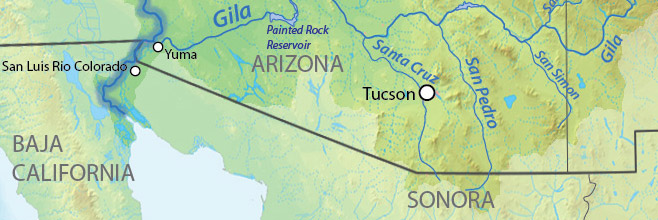Groundwater in Southern Arizona: People, Perceptions, and Policies
The fan made it difficult to hear, but the room was hot. Attendees were seated in tightly spaced rows, shoulder-to-shoulder. It was the Southeast Arizona Citizen’s Forum—a public meeting of the International Boundary and Water Commission that brings together stakeholders interested in water resources in the U.S.-Mexico border region. From my seat near the back, the rows of attendees looked like a motley assortment that together resembled a patchwork quilt—their clothing of various colors and styles—some wore suit jackets, others plaid shirts. There were cowboy boots, slacks, jeans, dress shirts, cardigans and work boots. As each person stood up to introduce themselves the diversity of stakeholders became even more apparent—representatives from U.S. Senator’s offices, state agency scientists, water utility professionals, local farmers, citizen activists, NGO employees, and concerned residents. Each raised their voice to be heard above the din of the air conditioner. They gathered to discuss water—each bringing a unique perspective.
In southern Arizona and along the border with Mexico, communities and industries are highly-dependent on groundwater. Yet, when people talk about water, they often focus on other things: “stream flows were so low this year”; “the pollution in the stream is getting worse”; “vegetation in the riparian area is suffering”; “this year’s monsoon was drier than normal”. Whether or not it is stated, all of these observed conditions can also affect groundwater, particularly shallow aquifers.
Image Source: WikiMedia CommonsIn the Upper Santa Cruz watershed—a transboundary basin that encompasses the border cities of Nogales, Sonora and Nogales, Arizona—water dialogues revolve around transboundary wastewater. Overflows of wastewater from Nogales, Sonora are transported via pipeline to be treated at the Nogales International Wastewater Treatment Plant, 10 miles north of the border. Many are concerned about the pipeline’s reliability and longevity as leaks contaminating the Nogales wash have been observed for years. At last fall’s Southeast Arizona Citizen’s Forum meeting, stakeholders questioned how repairs would be made—and who would pay for them. But this surface pollution could potentially also affect shallow groundwater—the main water source in this region.
Groundwater can be closely connected to surface water. In the Upper Santa Cruz basin, shallow aquifers are recharged from streams that flow only periodically during the year—the streams are fed by episodic rainfall mostly during the monsoon. Because surface water is scarce, riparian vegetation in the Upper San Pedro watershed—east of the Upper Santa Cruz—relies on groundwater to survive. And, recent studies suggest that reduced rainfall—an expected result of climate change—will likely also diminish the amount of recharge to aquifers in this region. Yet despite these intricate physical connections, groundwater and surface water—and their quantity and water quality—are managed, and often perceived, separately.
This is due in part to the fragmented and overlapping landscape of agencies that monitor, manage and regulate water. Federal laws address aspects of surface water quality, yet groundwater is regulated by the state and only in designated Active Management Areas. Monitoring of groundwater is the purview of the Arizona Department of Water Resources (ADWR), but the Arizona Department for Environmental Quality (ADEQ) takes the front seat on addressing pollution—which also affects groundwater. Thus, groundwater information is distributed across and used by multiple stakeholders.
In recent years, global efforts have shed light on the importance of groundwater resources and the need to better manage them for sustainable, long-term use. In 2016, the Global Environmental Facility identified a “Shared Vision for Groundwater Governance 2030” consisting of five principles that specifically include the need to integrate groundwater management with surface water management. The effort also identified the need for better information about groundwater resources and more effective use of scientific information groundwater planning and policies.
In southern Arizona, the state’s groundwater regulations go a long way to address these challenges, yet the roles, responsibility and scope of work among different actors remain both fragmented and overlapping—various organizations address a limited scope of groundwater concerns, stakeholders approach issues from different perspectives, and multiple agencies collect and compile groundwater data. This research seeks to examine the threads that connect scientific information and people’s perceptions of groundwater challenges—and between science and policy—to help us see groundwater management more clearly.


